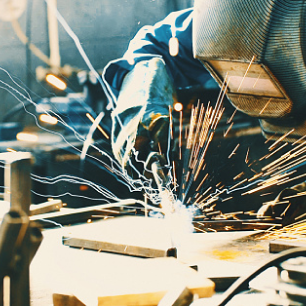Jump to:
Overcoming the Challenges of Ferrous Heat Exchanger Inspection
Heat exchangers play a crucial role in various industries by facilitating the efficient transfer of heat between fluids at different temperatures all while ensuring the fluids do not come into direct contact with each other. The shell and tube heat exchanger stands out as one of the most widely used designs among the different types of heat exchangers. This type of heat exchanger comprises a cylindrical shell enclosing a bundle of tubes — Fig. 1. While one fluid flows through the tubes, another fluid passes through the shell. Heat transfer occurs as heat is exchanged from the hot fluid to the cooler fluid through the walls of the tubes.
The tubes in a shell and tube heat exchanger are available in various materials depending on the specific application requirements. While both ferromagnetic and nonferromagnetic materials can be used, magnetic properties hold minimal significance in the selection process. Instead, the tube material is determined by factors such as the nature of the fluids, operating temperatures and pressures, and the potential presence of corrosive or abrasive substances within the fluids. The most common materials used for the tubes in a shell and tube heat exchanger include copper, stainless steel, titanium, carbon steel, and Inconel®, among others.
The critical role of tubing inspection
Tubing inspection ensures heat exchangers’ safety, reliability, and optimal performance. Over time, these essential components can develop various defects, such as corrosion, erosion, pitting, and cracking, significantly impacting their performance, energy efficiency, and overall safety. Hence, it is critical to inspect heat exchangers regularly to detect and address any emerging defects or issues.
Electromagnetic testing (ET) methods are commonly used to conduct tube inspections in heat exchangers. Conducting a tube inspection using ET methods requires meticulous preparation, careful selection of equipment and probes, and the execution of an accurate inspection procedure.
The inspection process typically involves inserting a probe into the tube through an opening in the bundle and pushing it along the entire length. Subsequently, the probe is pulled back manually or through an automated pusher-puller system while continuously monitoring and recording the eddy current signal. Figure 2 illustrates this tubing inspection process, depicting an inspector manually maneuvering the probe to examine the tubes within the bundle.
During the inspection, the probe generates a magnetic field that interacts with the tube’s material. Any variations in the material, such as cracks, corrosion, or other defects, can affect the eddy current signal, which is detected and analyzed to identify the location and characteristics of the defect. By employing robust tubing inspection techniques, heat exchangers can be safeguarded against equipment failures, maintenance costs can be reduced, and the life span of the equipment can be extended.
Complexity and carbon steel tube considerations
Inspecting heat exchangers poses significant challenges driven by their intricate design, varying sizes, and complexity. This process typically requires specialized equipment and expertise, potentially requiring considerable time and financial investments. Moreover, fouling, corrosion, or other defects further complicate inspections, risking inaccurate or incomplete results.
The consequences of missing the detection and characterization of key defects within heat exchanger tube bundles can be severe. Lengthy factory shutdowns during routine maintenance at petrochemical plants become inevitable, resulting in high costs. Even worse, undetected flaws can lead to unexpected production shutdowns, exacerbating the financial impact.
Some of the inherent difficulties when inspecting heat exchangers are as follows:
- Harsh environments: Heat exchangers are subjected to demanding operating conditions characterized by elevated temperatures, high
pressures, and corrosive chemicals. - Limited access: Often, tubing is situated within tight or hard-to-reach spaces, posing challenges to conducting comprehensive inspections of the tube bundle.
- Reduced data quality: Maintaining a consistent pulling speed through the day poses challenges for technicians manually handling the probe. Variations in probe pulling speed during acquisition can significantly impact data quality, slowing down the analyst’s job.
- Long and inconsistent acquisitions: For large exchangers, even a little additional time spent on each tube can result in significant overall delays, leading to prolonged and inconsistent acquisitions. This is particularly critical considering that heat exchangers’ average daily shutdown costs range between $2–4 million (U.S. currency).
- Limited detection capabilities with conventional methods: Conventional methods often exhibit restricted detection capabilities, potentially leading to overlooked flaws and shortcomings in identifying issues.
Choosing an appropriate inspection technique for heat exchangers hinges upon several factors, such as the tube material and the specific application requirements. Many heat exchangers in the industry are constructed using carbon steel tubing, which is prone to the formation of pits, corrosion, and cracks. High permeability and wall thickness can also pose challenges when using conventional examination methods. These defects are commonly observed in the free-span region and near or beneath support plates.
Advancements in carbon steel tube inspection
Although inspecting carbon steel tubes presents significant challenges, advancements in specialized equipment and techniques can offer effective alternatives. An example is Eddyfi Technologies’ ProbotTM, a probe pusher-puller system for tubing inspections in industrial applications — Fig. 3. This system surpasses Balance of Plants (BoP) inspection requirements and provides the oil and gas and other sectors with a productivity-enhancing tool. The device is sealed to IP65 standards, making it well-suited for various industrial applications. Probot integrates into Eddyfi Technologies’ product lineup, such as the Magnifi® and Ectane® data analysis and acquisition tools, which offer functionalities designed for inspecting tubing in industrial applications. Figure 4 depicts the full assembly of the probe pusher-puller system, including all the necessary accessories. This setup equips inspection professionals with what they need to conduct high-speed inspections of carbon steel tube heat exchangers.
Probot offers broad compatibility by employing most industry-standard probes, such as eddy current testing (ECT), remote-field testing (RFT), near-field testing (NFT), magnetic-field leakage (MFL), and soon, remote-field array (RFA). The system allows for precise control of the probe motion during heat exchanger inspections with speeds ranging from 0 to 8.2 ft/s (0 to 2.5 m/s), depending on the application. By automating the probe motion during heat exchanger inspections, the device delivers high-quality data at optimized speeds. Figure 5 illustrates an application of the system used for an inspection of a large heat exchanger.
Remote-field array examination
With more than a hundred tubes per bundle in a single petrochemical heat exchanger, inspection becomes a consequential job when numerous heat exchangers must be inspected during a shutdown. Time sensitivity and accuracy are crucial factors in this scenario. To ensure successful tubing inspection, it is vital to carefully choose the appropriate inspection technology in conjunction with using an automated pusher-puller system to optimize the process.
While RFT technology is widely used for inspecting carbon steel heat exchanger tubing, it does have inherent limitations. One major challenge is its ability to identify critical defects such as pitting, corrosion, and baffle wear, especially when these defects are concealed beneath or near support plates. Distinguishing these defects from the support plate signal itself poses a substantial challenge. Consequently, effectively detecting and characterizing critical defects like pitting and corrosion becomes challenging, potentially compromising the integrity of heat exchanger tubing.
The commonly used alternative to RFT, Internal Rotating Inspection System (IRIS), also comes with its own set of limitations. IRIS is relatively slow in acquisition speed compared to RFA at around 4 in./s (100 mm/s). This makes the inspection process time-consuming, especially when dealing with a large number of tubes in heat exchangers. Moreover, IRIS requires extensive preinspection preparation, involving thorough cleaning of the tubes to remove excessive fouling. In addition, the tubing needs to be filled with water to facilitate the transmission of ultrasonic waves. This preparation adds to the overall time investment and may result in additional water disposal costs.
Conducting RFA inspections requires the Ectane 3 inspection instrument and Magnifi acquisition and analysis software version 5.1 or higher, both of which are designed to support RFA technology and optimize data analysis. Figure 6 shows Ectane 3 with the new RFA probe.
The RFA probe’s design combines a conventional dual driver with two bobbin coils and a high-density array of coils. Leveraging a patent-pending, low-frequency multiplexing protocol, these RFA tube probes deliver high-resolution C-scan imaging for ferrous heat exchangers, achieving speeds comparable to conventional RFT acquisition, typically up to 12 in./s (300 mm/s).
The C-scan functionality of the RFA probe facilitates a visual scan around the circumference of the tube, leading to a better understanding of defect morphology and the probability of detection. During tube scanning with the RFA probe, conventional RFT strip charts and Lissajous plots for both absolute and differential channels are simultaneously acquired and displayed — Fig. 7.
RFA technology detects pits and small defects near tubesheets and support plates, providing an intuitive C-scan representation of the tube’s condition. The method also improves detection coverage by reducing blind zones around external features by up to 75% compared to standard RFT inspections. Figure 8 illustrates this capability through a comparison of strip charts and C-scans for both the absolute and differential channels using RFT and RFA.
As shown in Fig. 8, the strip charts recorded for the support plate with a machined through-wall hole show no major deviation from the nominal support plate signal. However, the absolute and differential C-scan signals indicate the presence of a defect, providing a distinct indication.
Conclusion
Automated pusher-puller systems and RFA technology present opportunities to enhance traditional inspection methods, benefiting industries. These advanced tools enable operators to efficiently and reliably collect real-time C-scans, facilitating the assessment of heat exchangers and ensuring a comprehensive inspection of tubing. By incorporating these methods and technology, petrochemical plants can prioritize equipment safety, minimize the risk of failures, and improve overall efficiency.
VAHID SHAHSAVARI (vshahsavari@eddyfi.com) is applications expert of tubing technologies, SÉBASTIEN SAVARD (ssavard@eddyfi.com) is senior applications expert, and DAVID AUBÉ (daube@eddyfi.com) is manager of tubing technologies, Eddyfi Technologies, Quebec, Canada.


